10 Onboarding Best Practices To Turn New Hires Into Lasting Employees
According to the U.S. Bureau of Labor Statistics, there were 5.8 million hires in July 2020. But there were also 5.0 million separations (quits, layoffs and discharges) in the same time period. Though this trend indicates that the job market is continuing to persevere through the fallout from COVID-19, the amount of turnover is still worrying. This is because the average cost of replacing an employee could be as high as $6,110!
That’s why it’s so important to onboard new hires diligently. You should aim to teach a new employee the relevant skills for the job and build their trust in the organization during the employee onboarding process.
Employees leave for a number of reasons: dissatisfaction with the management, low salary, lack of career advancement opportunities, insufficient benefits, etc. But many potential issues can be resolved by setting up new hires to succeed.
In this article, we look at 10 employee onboarding best practices that can increase employee productivity and improve retention.
Onboarding considerations for remote employees
In the wake of COVID-19, 82% of workers who had been working in an office transitioned to primarily working from home when the pandemic hit, according to our survey data (methodology below). Of those, only 50% have even been given a timeline for when they might be able to return to the office.
Many of the biggest companies in the world have expanded their work-from-home policies significantly, with companies like Twitter and Facebook going so far as to allow their employees to work from home indefinitely. In other words, you need to factor remote work into your onboarding plan.
The steps in this article are written with both remote employees and on-premise employees in mind. At the end of each section, we’ll include a tip on how to adapt these steps for remote workers.
1. Reach out to new hires before their start date
“Studies show that roughly 33% of employees decide to stay onboard with a firm or jump ship within their first 30 days of employment.”
Source: “The Importance Of Onboarding New Hires,” Dummies.com
If new hires are getting the silent treatment between accepting your offer and starting the job, you’re already sending the wrong message.
Maybe it’s an email from HR walking them through that first day, or a phone call from their new manager for a brief introduction. Whatever the medium, you should reach out to new hires before they begin, so they’re not going in completely blind.
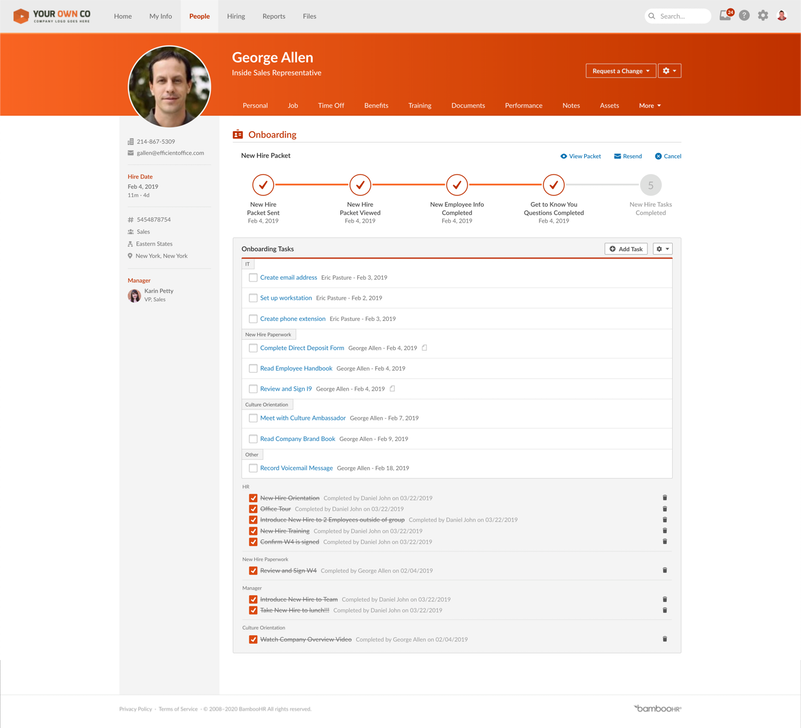
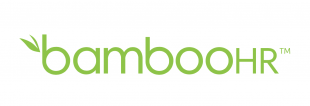
The New Hire Packet screen in the onboarding module of BambooHR (Source)
Setting up an onboarding portal that new hires can access online before their start date is an ideal solution. This way, new employees can start learning about the company on their own time and even get necessary forms out of the way.
Remote onboarding tip: You shouldn’t have to adapt too much for this step, since you’ll be contacting remote employees prior to their first day the same way you would an on-premise employee. But you should make sure that they have all relevant login information the same way you would make sure they have access to your facility.
2. Make their first day memorable
“Nearly 89% of new hires said that they wanted to meet with their new manager on the first day of employment, while 83% said they had the expectation of being introduced to colleagues on their first day in order to start off on a positive note.”
Source: “Why Do 28 Percent of Employees Quit in Their First 90 Days? Poor Onboarding Practices,” HRDive.com
“How was your first day?”
It’s a common question, and you don’t want new hires to answer with, “I spent all day filling out paperwork.” You don’t get a second chance to make a first impression, so ensure that their first day is a positive experience.
Here are some suggestions for starting new hires on the right foot:
Have their desk already set up with everything they need (ID badges, forms, account IDs and passwords etc.).
Give them a welcome package that includes gifts or messages from office mates.
Schedule a lunch with the new hire’s co-workers (and pay for it).
Send a company-wide email introducing your new hire to them.
For example, Twitter has an elaborate 75-step process for the first day. When employees arrive, the company has their email ID, a t-shirt and a bottle of wine waiting at their desk. In addition, new hires have breakfast with the CEO and a tour of the office before they get into first-day training.
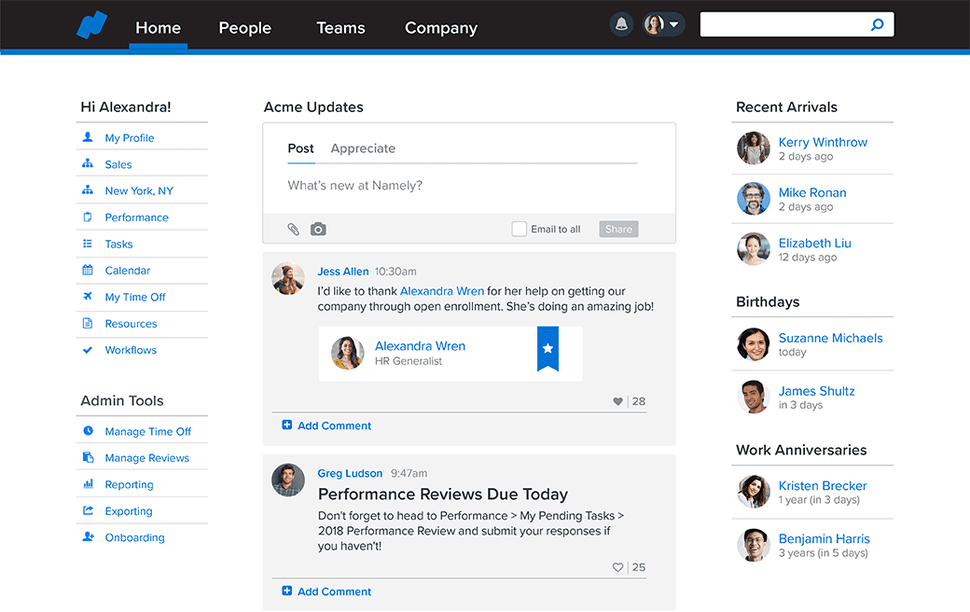

The update feed in Namely (Source)
Don’t be afraid to ask your current employees what they did or did not like about their first day, either. They’re key to making your new hires feel confident about their decision to work for your company.
Remote onboarding tip: Ship a welcome package with company swag (tee shirt, coffee mug, etc.) to the new employee’s home before their first day and send them a digital voucher for lunch with an invitation for an afternoon coffee or tea catch-up with their new team.
3. Keep their schedule tightly structured (at least to start)
“Organizations with a strong onboarding process improve new hire retention by 82% and productivity by over 70%.”
Source: “The True Cost of a Bad Hire,” Brandon Hall Group
Scheduling a new hire’s entire first week or two ahead of time has a couple of benefits. For one, they’ll never be left wondering what to do next.
Perhaps most importantly, it also gives the right impression: “Trust us. We know what we’re doing.”
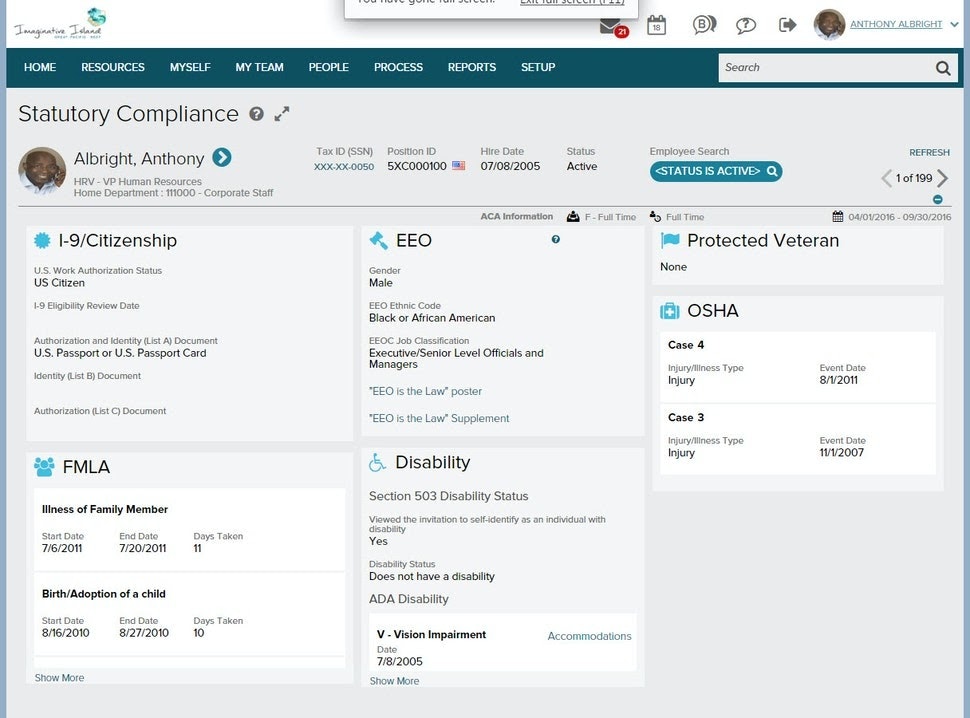

The candidate profile screen in ADP Workforce Now (Source)
Using a shared calendar or an onboarding platform, managers and HR users can create task lists and schedules for new hires, so they always know where they need to be and what they’ll be doing.
Even scheduling tasks as vague as “set up your computer to your liking” give new employees direction, so they can dive in instead of twiddling their thumbs.
As new hires get assignments and start ramping up, you can make their schedule less rigid to allow them to get work done at their own pace.
Remote onboarding tip: While virtual meeting overload can be a problem, it’s a good idea to schedule regular but brief video check-ins during a remote employee’s first week or two to accelerate their connection to the team. This can be with a mentor or small group. For training, use a combination of self-guided modules and live instructor-led sessions to increase engagement.
4. Form a cross-departmental onboarding team
“In a study that followed 409 college graduates through their first two years on the job, the degree of supervisor support that new employees felt during that time period had implications for role clarity, job satisfaction and even their salary over time.”
Source: “Your New Hires Won’t Succeed Unless You Onboard Them Properly,” Harvard Business Review
HR knows compliance; management knows performance expectations; coworkers know the day-to-day; and IT knows how to get equipment up and running. Forming a small team with members from each of these departments helps ensure that you’ve covered every new hire-related topic before they even walk through the front door.
Even a simple email thread can allow team members to collaborate, lay out individualized onboarding plans and leave room for feedback if a course correction is needed.
For example, if a new hire is learning the ropes faster than expected, a coworker might suggest that management assign their first project sooner.
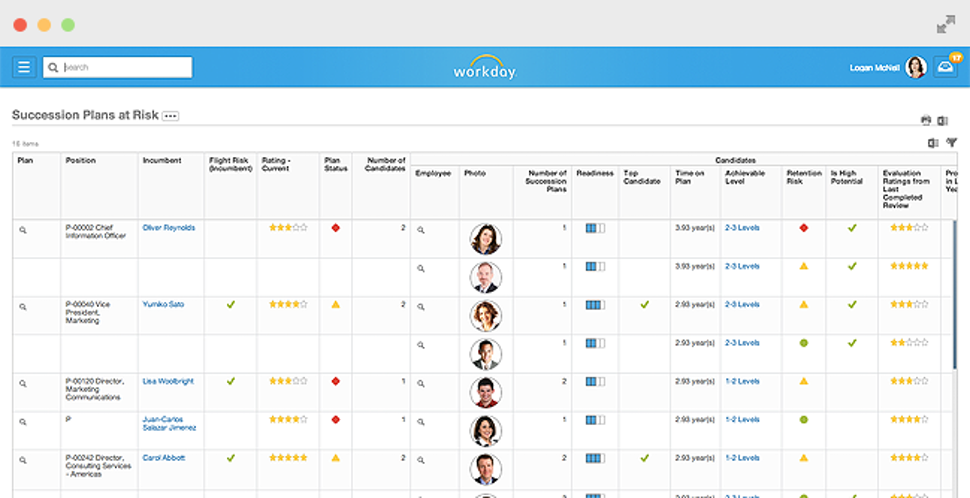

Succession planning in Workday (Source)
Providing a buddy or mentor who works in the same department as your new hire is also a good idea. In fact, Gartner research shows that 74% of new hires consider their peers to be the most helpful source of support during onboarding. The new hire gets a point person for any of their questions, comments or concerns, and the mentor gets an opportunity to demonstrate leadership.
Gartner suggests setting up both a “peer” buddy, to help guide the new hire through their individual role and acclimate to their direct team, as well as a “connector” buddy from another business unit, to help the new hire navigate the larger organization and understand the company culture (full report available to clients).
Remote onboarding tip: Schedule out a series of new hire introductory meetings to familiarize them with the different teams in your organization throughout the year. These can be once every month or two, depending on the size of your company, and include all the new hires from the previous month.
5. Spread out the paperwork
“Eighty percent of HR administrations say onboarding paperwork is completed in person at a desk or in a conference room.”
Source: ADP
I-9s, employee handbooks, payroll forms, non-disclosure agreements—there’s a reason onboarding is often associated with a ton of paperwork. But if you drop all of the necessary forms on your new hire all at once, they could become disenchanted, or worse, overwhelmed.
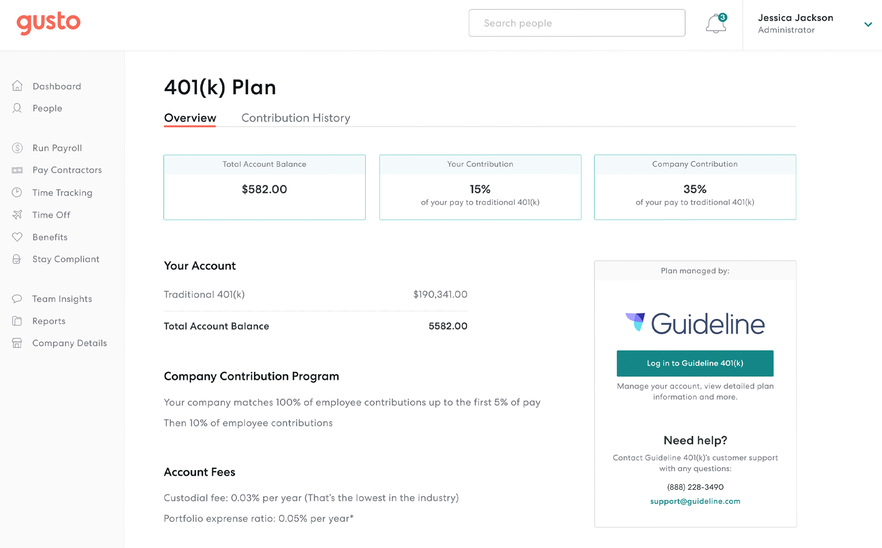

401(k) plan overview in Gusto (Source)
Instead, spread the paperwork out and give new hires some autonomy in completing it on their own time. Using onboarding software, you can put all necessary forms online and assign due dates for completion.
This gives new hires some freedom as to when and where they sign the dotted line—but lets you keep track of which forms are completed, and which are still in progress.
Remote onboarding tip: An online onboarding portal is a must for remote employees to fill out necessary paperless forms without having to come into an office or mail paperwork.
6. Get the whole company involved
“A meta-analysis conducted by two of us examined the findings of 70 separate studies and showed that feeling socially accepted was a key factor in newcomer success. Integrating into the social network matters, in part, because it brings greater access to information and resources.”
Source: “Your New Hires Won’t Succeed Unless You Onboard Them Properly,” Harvard Business Review
The saying goes that “it takes a village to raise a child.” It also takes a whole company to get new hires integrated and up to speed.
Schedule some one-on-one time between new hires and veteran workers in every relevant department during their first few weeks, including job shadowing (when possible).
This will allow new employees to see how their role fits into the big picture at your organization. What’s more, it can also foster vital interdepartmental collaboration: You never know, for example, when your new salesperson will have a brilliant marketing idea.
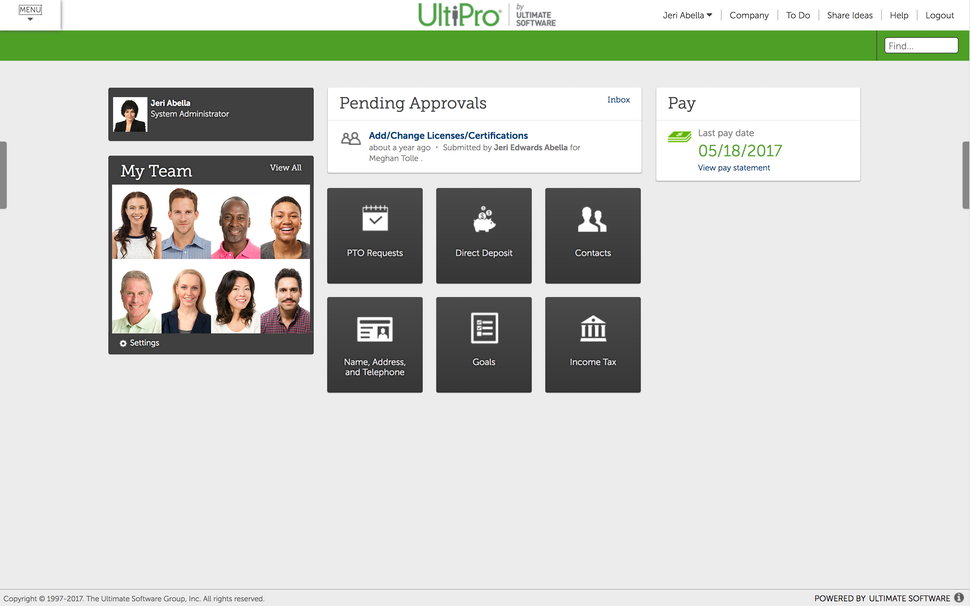

The employee dashboard with team view in UltiPro (Source)
Another advantage is that if departments end up working together in the future, the stakeholders will already be familiar with each other.
Remote onboarding tip: In lieu of physical shadow sessions, set up training sessions where veteran employees from different departments teach new employees a valuable task from their job, such as social media posting or IT security best practices. Inviting and introducing new hires to relevant channels in your collaboration tool is another great way to connect them to different teams.
7. Set expectations early and often
“Fifty-eight percent of employees are likely to stay at a company for three years if they experience a great onboarding program.”
Source: “The Business Case for Investing in Onboarding Programs,” Paycor
When it comes to setting role responsibilities and performance goals, vagueness is the enemy. Setting defined (but realistic) expectations for new hires from the get-go—and communicating them clearly—can help workers evaluate their own progress and prepare for what’s to come.
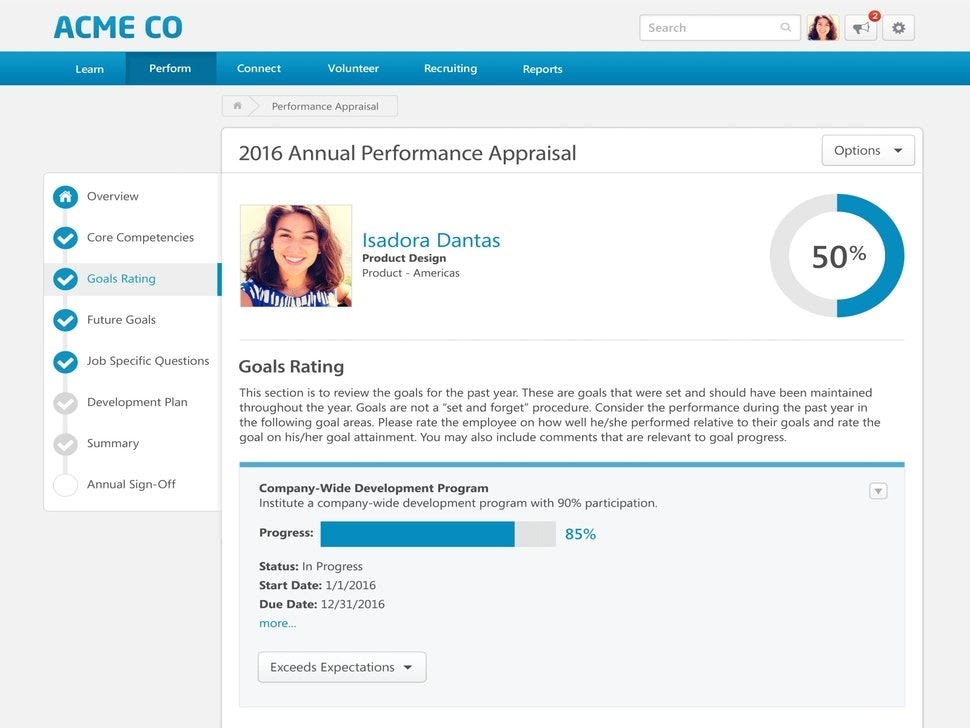

The performance appraisal screen in Cornerstone OnDemand (Source)
Set short-term and long-term goals, then have managers check in regularly to see if new hires are meeting them. For example, a short-term goal might be, “finish 50% of the sales training videos by Friday,” while a long-term goal could be, “complete 10 projects within the next six months.”
Software allows you to create and modify these goals with ease, while also giving you a real-time glimpse into your new hire’s progress. After a couple of months, a formal performance review should be scheduled to give new employees honest feedback on how they’re doing. And of course, don’t forget to heap praise on those who deserve it.
Remote onboarding tip: Regular performance check-ins are especially important for remote employees, both to help the employee feel like their work is being recognized and appreciated, and for the manager to dispel any concerns that a remote employee is not as effective as an on-premise employee.
8. Allow new hires to give their own feedback
“In a recent poll, 38% of employees felt that when leaders dismiss their ideas without entertaining them, they tend to lack initiative. An active and committed employee base is one of the benefits of listening to your employees.”
Source: “5 Reasons Why You Should Listen to Your Employees,” SHRM
Are new hires going to tell you something about your company is awful on their first day? Probably not. But if you leave avenues for honest feedback open, workers will be more inclined to present solutions to problems you may not even know you have.
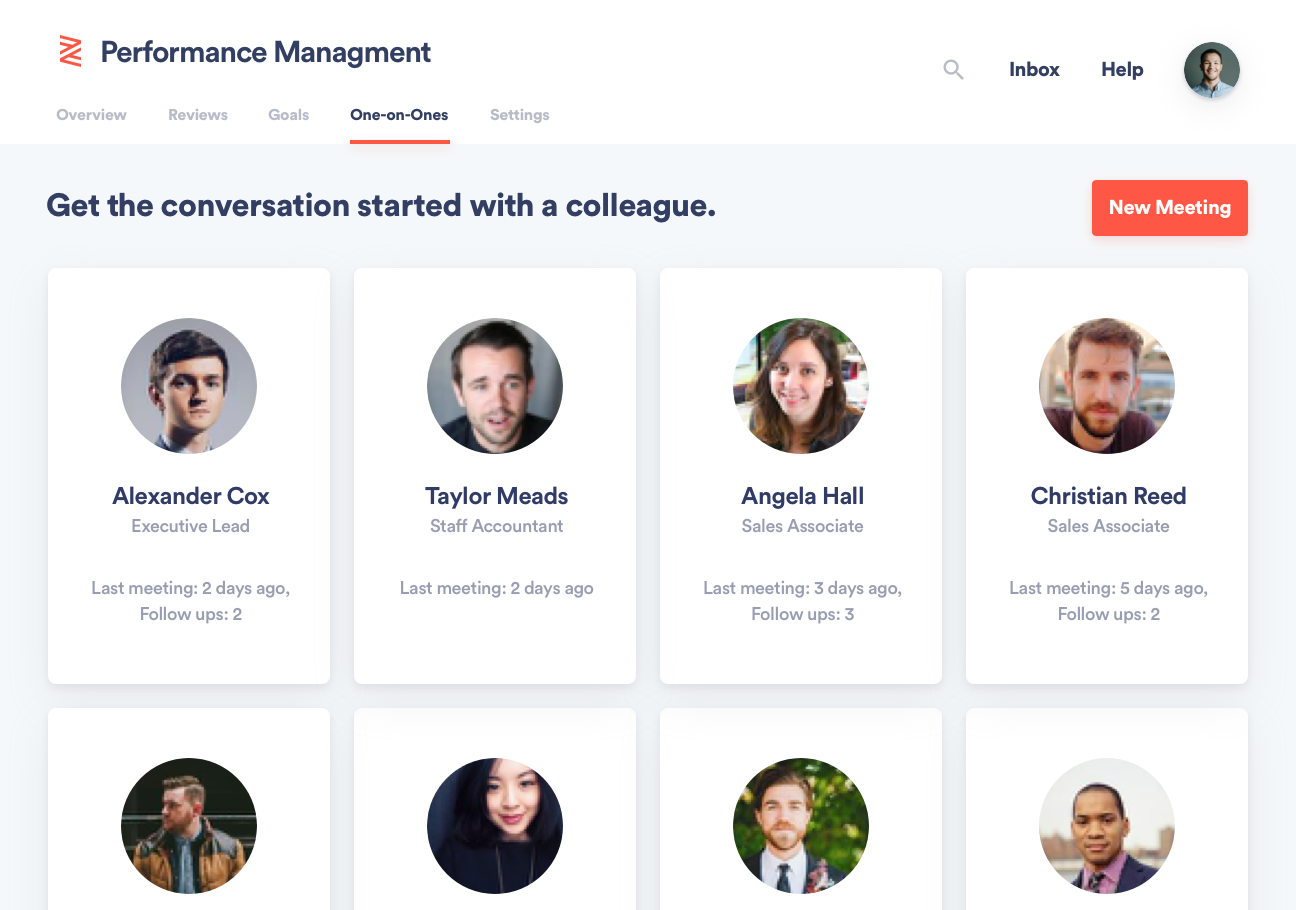
Performance management in Zenefits (Source)
The onboarding process provides an opportunity that can benefit your entire organization: a fresh perspective. Don’t be afraid to ask new hires what they like and don’t like about their job thus far—perhaps through an anonymous survey.
Should you implement their feedback, new hires will feel heard, and you’ll have made improvements because of it. That’s a win-win.
Remote onboarding tip: Remote employees may have a valuable perspective on things like the effectiveness of your virtual conferencing technology and how well you’re communicating with your remote teams. To encourage feedback, send out formal surveys or schedule informal feedback sessions rather than waiting for a new hire to volunteer their thoughts.
9. Communicate the culture early and often
“A one star increase in career opportunities and culture and values ratings on Glassdoor raises the odds that employees will stay at their companies when moving into their next role by five percent, respectively.”
Source: “Why Do Workers Quit? The Factors that Predict Employee Turnover,” Glassdoor
Unless your recruiters failed to adequately examine their skills, your new hires probably aren’t going to fail because they don’t know how to do their job. More likely, they’re going to fail because their work habits and personality don’t mesh well with your company culture.
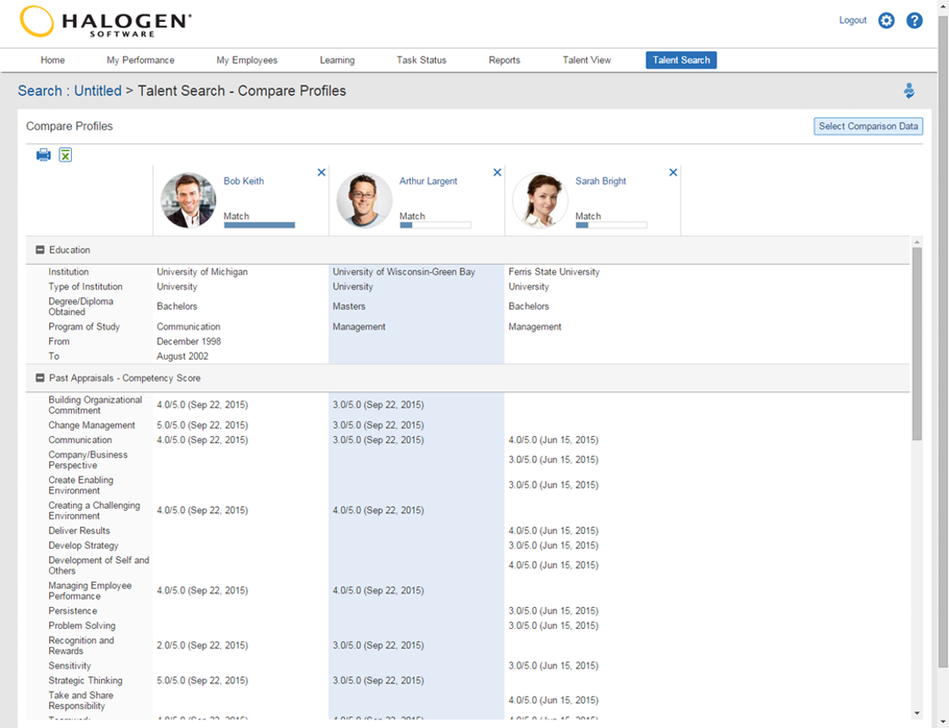
Candidate assessments in Saba TalentSpace
The obvious solution? Don’t hire those workers in the first place. To learn whether your company and an applicant are a match, many recruiting platforms include functionality for pre-employment assessments. These assessments can help determine whether a candidate will be a good fit for your culture.
Even after applicants become employees, a concerted effort should be made to communicate and emphasize your organization’s culture.
Presenting an honest view of your company culture can help new hires decide if it’s a match, or if they need to find an employer more aligned with their style.
Remote onboarding tip: Set remote work expectations early and have a clear remote work policy in place to avoid misunderstandings. Just because an employee isn’t online right at 9 a.m. everyday doesn’t mean they’re not working a full day.
10. Don’t expect new hires to hit the ground running
“…It takes up to eight months for a new hire to reach full potential….”
Source: "How to Make New Employees More Productive, According to Research," Inc.com
The phrase “hit the ground running” gets thrown around a lot with new employees. Have you ever actually tried to hit the ground running? This is what happens.
While it can be tempting to speed up onboarding and training so your employees can start producing, this can actually be detrimental to worker development and retention in the long run.
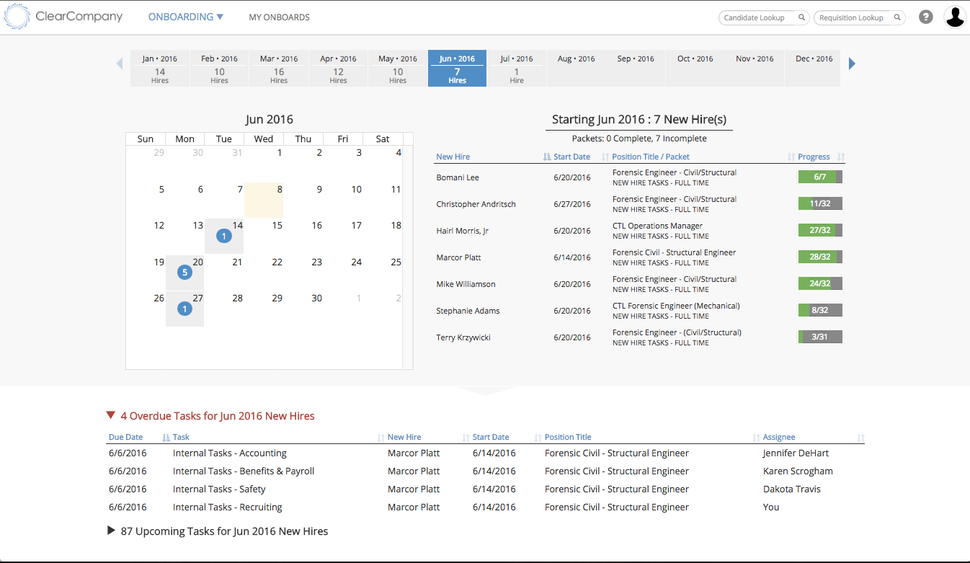
The onboarding calendar in ClearCompany HRM
Effective onboarding and new hire integration takes time. As mentioned, organizations can use onboarding software to schedule regular activities throughout a new hire’s first year to provide structure and allow for feedback. In this case, slow and steady really does win the race.
Remote onboarding tip: Make sure your remote employees have the same tools for success that your on-premise employees would have (within reason). If a remote employee is off to a slow start it might just mean that they need a faster computer, a software update, or a new ergonomic chair.
Conclusion and next steps
Armed with these best practices, the next step is to check out the software we’ve mentioned here in detail. Here’s where you should start:
Buyers guide: Our buyers guide provides a rundown of what to expect with onboarding software—the functionality, the different implementation models, market trends, etc.
HR software FrontRunners: This list of top rated and reviewed products features many solutions that offer onboarding functionality. It’ll help you identify which solutions are popular among users for their functionality and efficiency.
Pricing guide: Once you shortlist solutions, the next step is to check which solution fits in your budget. This free to download pricing guide explains the different pricing models and prices of popular HR solutions. It’s definitely a handy guide.
Talk to an advisor: Our software advisors are available for a free FastStart consultation at (844) 675-2849. They can help you shortlist solutions further based on your exact needs. They’ve helped tens of thousands of businesses address their pain points by using the right software.
Explore HR categories:
Survey methodology
The Software Advice COVID-19 Employee Impact Survey was conducted in May 2020. We surveyed 376 full- and part-time employees at U.S.-based businesses. We worded the questions to ensure that each respondent fully understood the meaning and the topic at hand.
Note: The applications selected in this article are examples to show a feature in context and are not intended as endorsements or recommendations. They have been obtained from sources believed to be reliable at the time of publication.